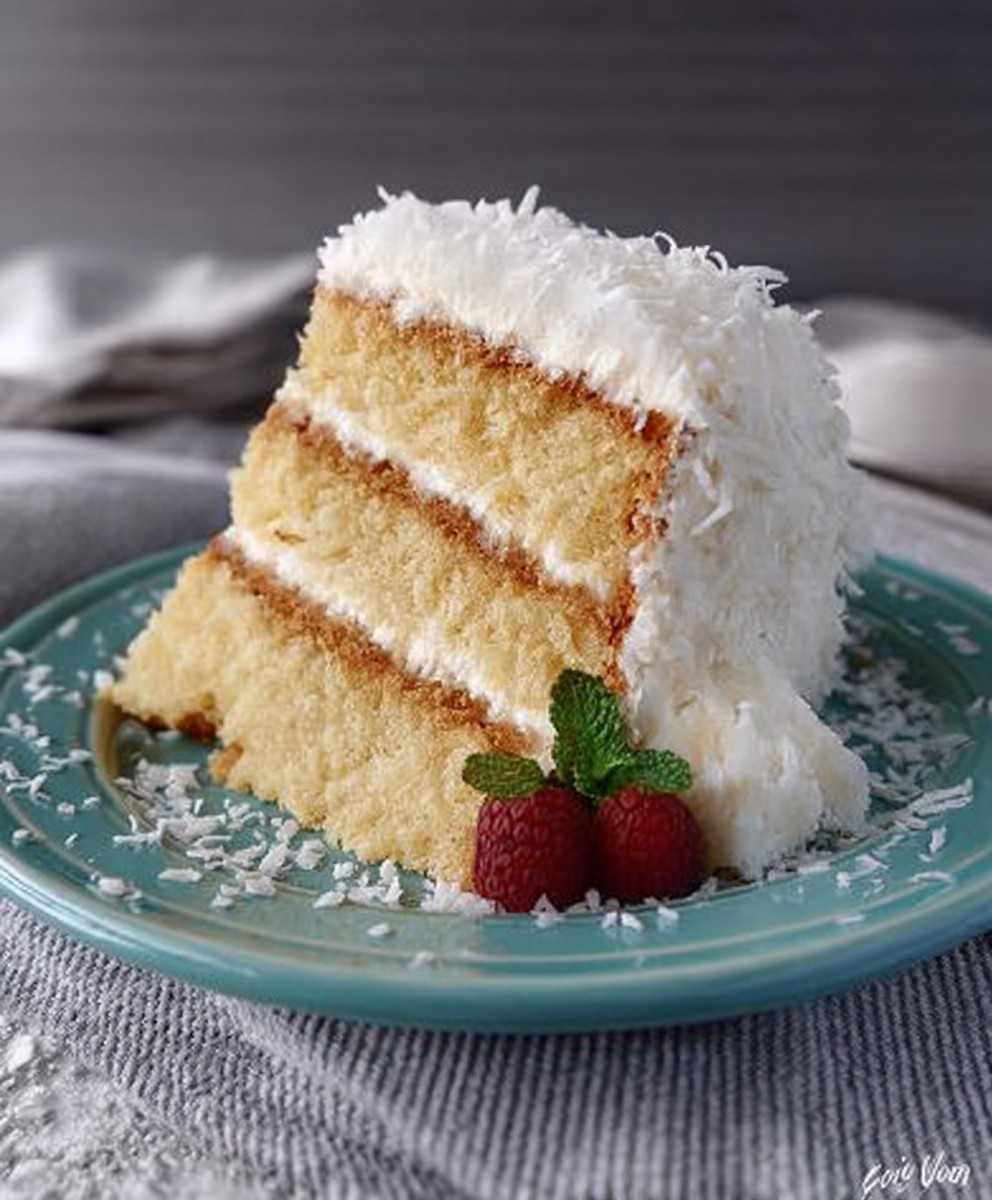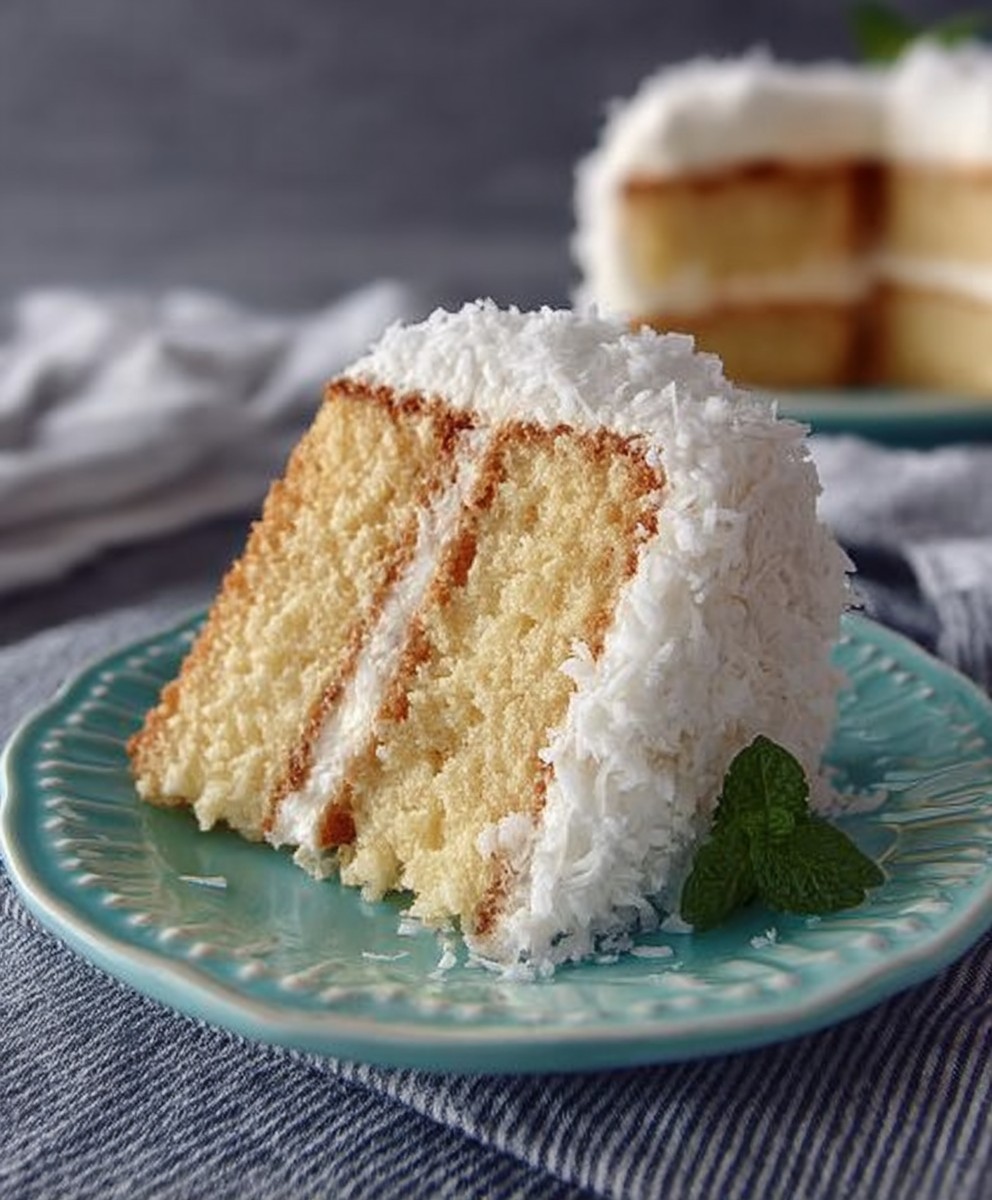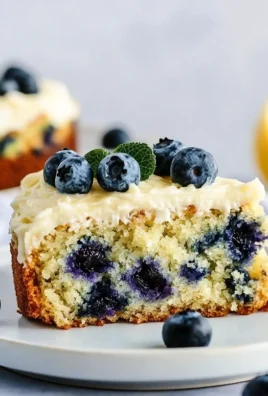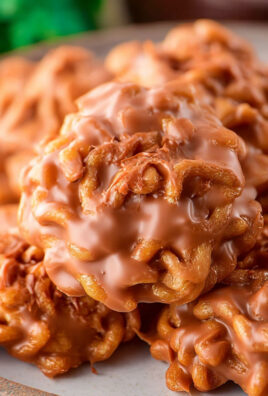Coconut Cake: Just the name conjures images of tropical breezes, sunshine, and pure, unadulterated deliciousness, doesn’t it? I’m thrilled to share my foolproof recipe for this classic dessert that’s guaranteed to be a showstopper at your next gathering. Forget dry, crumbly versions you might have encountered; this cake is unbelievably moist, tender, and bursting with coconut flavor in every single bite.
While the exact origins of coconut cake are debated, it’s widely believed to have gained popularity in the American South during the 19th century, coinciding with increased trade and availability of coconuts. It quickly became a staple at celebrations, holidays, and family gatherings, symbolizing hospitality and warmth. The simple elegance of a perfectly frosted coconut cake belies the incredible depth of flavor it offers.
What is it about coconut cake that makes it so irresistible? Perhaps it’s the delicate sweetness of the coconut, perfectly balanced by the richness of the cake. Or maybe it’s the satisfyingly soft and fluffy texture that practically melts in your mouth. Whatever the reason, this cake is a crowd-pleaser for a reason. It’s also surprisingly easy to make, and my recipe simplifies the process even further, ensuring a perfect result every time. So, let’s get baking and bring a little taste of paradise to your kitchen!
Ingredients:
- 2 1/2 cups all-purpose flour
- 1 teaspoon baking powder
- 1/2 teaspoon baking soda
- 1/2 teaspoon salt
- 1 cup (2 sticks) unsalted butter, softened
- 1 3/4 cups granulated sugar
- 3 large eggs
- 1 teaspoon vanilla extract
- 1 (13.5 ounce) can full-fat coconut milk
- 1/2 cup sour cream
- 1 cup shredded sweetened coconut, divided (1/2 cup for batter, 1/2 cup for topping)
Preparing the Cake Batter:
- Preheat your oven and prepare your pan. First things first, let’s get that oven preheated to 350°F (175°C). While it’s heating up, grease and flour a 9×13 inch baking pan. You can also use baking spray with flour already in it that works like a charm! This ensures the cake doesn’t stick and comes out easily.
- Combine dry ingredients. In a medium bowl, whisk together the flour, baking powder, baking soda, and salt. Whisking is key here to evenly distribute the leavening agents and salt throughout the flour. This will help the cake rise properly and have a consistent texture. Set this bowl aside for now.
- Cream butter and sugar. In a large bowl (or the bowl of your stand mixer), cream together the softened butter and granulated sugar until light and fluffy. This usually takes about 3-5 minutes on medium speed. The mixture should become noticeably lighter in color and increase in volume. This step is crucial for incorporating air into the batter, which contributes to a tender crumb.
- Add eggs and vanilla. Beat in the eggs one at a time, making sure each egg is fully incorporated before adding the next. After the eggs are in, stir in the vanilla extract. Don’t overmix at this stage; just mix until everything is combined. Overmixing can develop the gluten in the flour, leading to a tougher cake.
- Alternate adding dry and wet ingredients. Gradually add the dry ingredients to the wet ingredients, alternating with the coconut milk and sour cream. Begin and end with the dry ingredients. So, add about 1/3 of the dry ingredients to the butter mixture and mix until just combined. Then, add half of the coconut milk and mix. Next, add another 1/3 of the dry ingredients and mix. Follow with the sour cream and mix. Finally, add the remaining dry ingredients and mix until just combined. Be careful not to overmix! Overmixing will result in a tough cake.
- Fold in coconut. Gently fold in 1/2 cup of the shredded sweetened coconut. This adds a lovely coconut flavor and texture to the cake. Make sure the coconut is evenly distributed throughout the batter.
- Pour batter into pan. Pour the batter into the prepared baking pan and spread it evenly.
Baking the Cake:
- Bake the cake. Bake in the preheated oven for 30-35 minutes, or until a wooden skewer inserted into the center comes out clean. Keep an eye on the cake; baking times can vary depending on your oven. If the top of the cake starts to brown too quickly, you can loosely tent it with aluminum foil.
- Cool the cake. Let the cake cool in the pan for 10-15 minutes before inverting it onto a wire rack to cool completely. Cooling the cake in the pan helps it to set and prevents it from breaking when you invert it.
Preparing the Coconut Cream Cheese Frosting:
- 8 ounces cream cheese, softened
- 1/2 cup (1 stick) unsalted butter, softened
- 4 cups powdered sugar
- 1 teaspoon vanilla extract
- 2-4 tablespoons milk or coconut milk (for desired consistency)
- Cream cheese and butter. In a large bowl (or the bowl of your stand mixer), beat together the softened cream cheese and butter until smooth and creamy. Make sure both the cream cheese and butter are at room temperature to prevent lumps in the frosting.
- Add powdered sugar. Gradually add the powdered sugar, one cup at a time, beating well after each addition. Start on low speed to prevent the powdered sugar from flying everywhere!
- Add vanilla and milk. Stir in the vanilla extract. Then, add milk or coconut milk, one tablespoon at a time, until the frosting reaches your desired consistency. You want it to be smooth, creamy, and spreadable.
Frosting and Decorating the Cake:
- Frost the cake. Once the cake is completely cool, frost it with the coconut cream cheese frosting. Use an offset spatula or a knife to spread the frosting evenly over the top and sides of the cake.
- Sprinkle with coconut. Sprinkle the remaining 1/2 cup of shredded sweetened coconut over the top of the frosted cake. This adds a beautiful finishing touch and enhances the coconut flavor.
- Chill (optional). For best results, chill the frosted cake in the refrigerator for at least 30 minutes before serving. This allows the frosting to set and makes the cake easier to slice.
- Slice and serve. Slice the cake into squares and serve. Enjoy! This coconut cake is perfect for any occasion, from birthdays to potlucks to a simple weeknight dessert.
Tips and Variations:
Using Coconut Oil:
For an even more intense coconut flavor, you can substitute half of the butter with coconut oil. Make sure the coconut oil is solid but softened, not melted. This will add a subtle coconut aroma and a slightly denser texture to the cake.
Adding Pineapple:
For a tropical twist, consider adding crushed pineapple to the batter. Drain the pineapple well before adding it to prevent the cake from becoming soggy. About 1 cup of drained crushed pineapple would be a great addition.
Toasting the Coconut:
Toasting the shredded coconut before using it as a topping will enhance its flavor and add a bit of crunch. To toast the coconut, spread it in a single layer on a baking sheet and bake at 350°F (175°C) for 5-7 minutes, or until lightly golden brown. Watch it carefully, as it can burn quickly.
Coconut Extract:
If you want to boost the coconut flavor even further, add 1/2 teaspoon of coconut extract to the batter along with the vanilla extract. Be careful not to add too much, as coconut extract can be quite strong.
Making it Gluten-Free:
To make this cake gluten-free, substitute the all-purpose flour with a gluten-free all-purpose flour blend. Make sure the blend contains xanthan gum, which helps to bind the ingredients together. You may also need to add a bit more liquid to the batter, as gluten-free flours tend to absorb more moisture.
Storing the Cake:
Store the frosted cake in an airtight container in the refrigerator for up to 3 days. The cake can also be frozen for longer storage. Wrap the cake tightly in plastic wrap and then in aluminum foil before freezing. Thaw the cake in the refrigerator overnight before serving.
Adjusting Sweetness:
If you prefer a less sweet cake, you can reduce the amount of sugar in the batter by 1/4 cup. You can also use unsweetened shredded coconut instead of sweetened shredded coconut.
Using Different Pans:
While this recipe is designed for a 9×13 inch pan, you can also use two 9-inch round cake pans. If using round pans, reduce the baking time by a few minutes. You can also make cupcakes using this recipe. Fill cupcake liners about 2/3 full and bake for 18-20 minutes.
Coconut Flakes vs. Shredded Coconut:
While shredded coconut is called for in this recipe, you can experiment with coconut flakes. Coconut flakes are larger and have a slightly different texture than shredded coconut. If using coconut flakes, you may want to chop them up a bit before adding them to the batter or using them as a topping.
Making a Coconut Glaze:
Instead of frosting the cake with cream cheese frosting, you can make a simple coconut glaze. To make the glaze, whisk together 1 cup of powdered sugar with 2-3 tablespoons of coconut milk until smooth. Pour the glaze over the cooled cake and let it set before serving.
Adding Lime Zest:
For a refreshing twist, add the zest of one lime to the batter along with the vanilla extract. The lime zest will complement the coconut flavor beautifully.
Using Brown Butter:
For a richer, nuttier flavor, you can brown the butter before adding it to

Conclusion:
This isn’t just another cake recipe; it’s an invitation to experience pure tropical bliss. From the first bite of the moist, tender crumb infused with the delicate sweetness of coconut, you’ll understand why this coconut cake is a must-bake for any occasion. It’s the kind of cake that evokes memories of sunny beaches and carefree days, a little slice of paradise right in your own kitchen.
But what truly elevates this recipe is its versatility. While it’s absolutely divine as is, a simple dusting of powdered sugar or a generous dollop of whipped cream makes it instantly elegant. For a more decadent treat, consider a rich cream cheese frosting, perhaps with a hint of lime zest to complement the coconut. Or, if you’re feeling adventurous, try incorporating toasted coconut flakes into the batter for an extra layer of texture and flavor.
Serving suggestions are endless! This cake is perfect as an afternoon treat with a cup of coffee or tea. It’s also a show-stopping dessert for dinner parties, birthdays, or any special celebration. Imagine serving it with a scoop of vanilla ice cream and a drizzle of caramel sauce pure indulgence! And for a truly tropical experience, pair it with a refreshing coconut cocktail.
I’ve poured my heart into perfecting this recipe, and I’m confident that you’ll love it as much as I do. It’s surprisingly easy to make, even for beginner bakers, and the results are simply outstanding. The aroma alone, as it bakes in the oven, is enough to transport you to a tropical island.
Don’t just take my word for it, though. I wholeheartedly encourage you to give this recipe a try. I promise you won’t be disappointed. It’s a guaranteed crowd-pleaser, and it’s sure to become a new family favorite.
Once you’ve baked your own slice of paradise, I’d absolutely love to hear about your experience! Did you try any variations? Did you add any special touches of your own? Share your photos and stories in the comments below. Let’s create a community of coconut cake lovers!
I’m always eager to learn from your baking adventures and see how you’ve made this recipe your own. Your feedback is invaluable, and it helps me continue to improve and share even more delicious recipes with you. So, don’t be shy let me know what you think!
Happy baking, and I can’t wait to hear all about your coconut cake creations! Remember, baking is all about sharing the love, one delicious slice at a time. Enjoy!
Coconut Cake: The Ultimate Recipe and Baking Guide
Moist coconut cake made with coconut milk and shredded coconut, topped with creamy coconut cream cheese frosting and more coconut. Perfect for any occasion.
Ingredients
- 2 1/2 cups all-purpose flour
- 1 teaspoon baking powder
- 1/2 teaspoon baking soda
- 1/2 teaspoon salt
- 1 cup (2 sticks) unsalted butter, softened
- 1 3/4 cups granulated sugar
- 3 large eggs
- 1 teaspoon vanilla extract
- 1 (13.5 ounce) can full-fat coconut milk
- 1/2 cup sour cream
- 1 cup shredded sweetened coconut, divided (1/2 cup for batter, 1/2 cup for topping)
- 8 ounces cream cheese, softened
- 1/2 cup (1 stick) unsalted butter, softened
- 4 cups powdered sugar
- 1 teaspoon vanilla extract
- 2-4 tablespoons milk or coconut milk (for desired consistency)
Instructions
- Preheat oven to 350°F (175°C). Grease and flour a 9×13 inch baking pan.
- In a medium bowl, whisk together flour, baking powder, baking soda, and salt.
- In a large bowl, cream together softened butter and granulated sugar until light and fluffy (3-5 minutes).
- Beat in eggs one at a time, then stir in vanilla extract.
- Gradually add dry ingredients to wet ingredients, alternating with coconut milk and sour cream, beginning and ending with dry ingredients. Mix until just combined after each addition.
- Gently fold in 1/2 cup shredded sweetened coconut.
- Pour batter into prepared pan and spread evenly. Bake for 30-35 minutes, or until a wooden skewer inserted into the center comes out clean.
- Let cake cool in the pan for 10-15 minutes before inverting it onto a wire rack to cool completely.
- In a large bowl, beat together softened cream cheese and butter until smooth and creamy.
- Gradually add powdered sugar, one cup at a time, beating well after each addition.
- Stir in vanilla extract. Then, add milk or coconut milk, one tablespoon at a time, until the frosting reaches your desired consistency.
- Once the cake is completely cool, frost it with the coconut cream cheese frosting.
- Sprinkle the remaining 1/2 cup of shredded sweetened coconut over the top of the frosted cake.
- For best results, chill the frosted cake in the refrigerator for at least 30 minutes before serving.
- Slice the cake into squares and serve.
Notes
- For a more intense coconut flavor, substitute half of the butter with coconut oil (solid but softened).
- Add crushed pineapple (drained) to the batter for a tropical twist.
- Toast the shredded coconut before using it as a topping for enhanced flavor.
- Add coconut extract to the batter for a stronger coconut flavor.
- To make gluten-free, substitute all-purpose flour with a gluten-free all-purpose flour blend.
- Store frosted cake in an airtight container in the refrigerator for up to 3 days.
- Reduce sugar for a less sweet cake.
- Can use two 9-inch round cake pans or make cupcakes (adjust baking time).
- Experiment with coconut flakes instead of shredded coconut.
- Make a coconut glaze instead of frosting.
- Add lime zest for a refreshing twist.
- For a richer, nuttier flavor, you can brown the butter before adding it to




